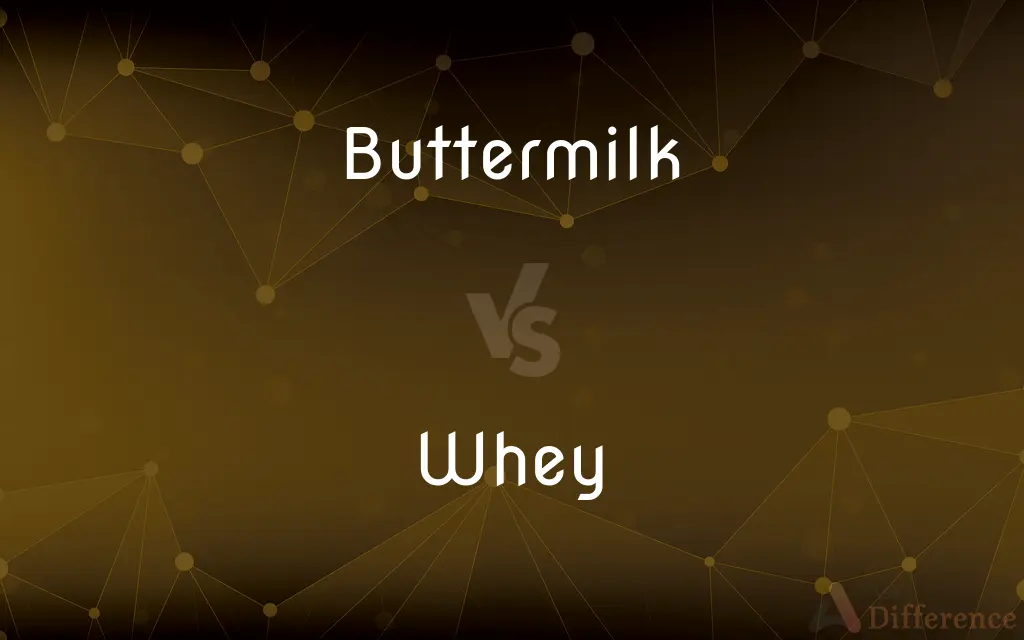Buttermilk vs. Whey — What's the Difference?
By Urooj Arif & Fiza Rafique — Updated on March 18, 2024
Buttermilk is a tangy dairy product left after churning butter, traditionally rich in lactic acid bacteria, while whey is the liquid remaining after milk has been curdled and strained, often used in protein supplements and food production.

Difference Between Buttermilk and Whey
Table of Contents
ADVERTISEMENT
Key Differences
Traditionally, buttermilk referred to the liquid left over from churning butter out of cream. This type of buttermilk is characterized by its slightly sour taste due to the fermentation process, which also introduces beneficial lactic acid bacteria. Whey, on the other hand, is a byproduct of cheese or casein production when milk is curdled and strained. It contains lactose, vitamins, proteins, and minerals, with a more watery consistency than buttermilk.
Modern buttermilk, often found in supermarkets, is cultured buttermilk, made by adding lactic acid bacteria to milk, thickening it, and giving it a tangy flavor. It's widely used in baking and cooking for its acidity and ability to react with baking soda, resulting in light, fluffy textures. Whey is categorized into two main types: sweet whey and acid whey, derived from the production of rennet-based cheeses and acidified dairy products, respectively. Whey protein, a popular dietary supplement, is extracted from this liquid and valued for its high-quality protein, essential for muscle repair and growth.
The primary distinction between buttermilk and whey lies in their production processes and resulting nutritional profiles. Buttermilk's lactic acid content makes it excellent for tenderizing baked goods, while whey's protein richness makes it a favored supplement in fitness and health circles. Both buttermilk and whey contribute unique flavors and textures to recipes, with buttermilk offering a creamy thickness and tangy taste, and whey providing a lighter, more liquid consistency with a slightly sweet flavor.
In terms of culinary applications, buttermilk is often used in recipes like pancakes, biscuits, and dressings, where its acidity can react with baking soda for leavening and add a creamy tang. Whey finds its use in various food products, including beverages, baked goods, and as a nutritional enhancement in health-oriented foods. It's also employed in animal feed and in the beauty industry for hair and skincare products, showcasing its versatility beyond culinary uses.
Understanding the differences between buttermilk and whey can enhance culinary practices and dietary choices, recognizing each for their unique contributions to flavor, texture, and nutrition in a diverse range of dishes and products.
ADVERTISEMENT
Comparison Chart
Definition
The liquid leftover from churning butter, now often cultured for tanginess.
The liquid remaining after milk is curdled and strained during cheese production.
Primary Components
Lactic acid, fat traces, vitamins, and minerals.
Lactose, protein (especially whey protein), vitamins, and minerals.
Consistency
Thicker, creamy.
Watery, more liquid.
Taste
Tangy, slightly sour.
Mild, slightly sweet.
Uses in Cooking
Baking, dressings, marinating.
Protein supplements, baking, beverages.
Nutritional Focus
Beneficial bacteria, good for digestion.
High-quality protein, essential for muscle repair and growth.
Types
Traditional (from butter churning), Cultured (with added bacteria).
Sweet whey (from rennet-based cheese), Acid whey (from acidified dairy products).
Compare with Definitions
Buttermilk
Buttermilk is a tangy dairy product traditionally left from making butter.
Buttermilk pancakes are prized for their light and fluffy texture.
Whey
Whey is the liquid byproduct of cheese or yogurt production.
Whey protein shakes are popular among athletes for muscle recovery.
Buttermilk
Cultured buttermilk is common in stores, made by fermenting milk with bacteria.
She used cultured buttermilk to add tanginess to her salad dressing.
Whey
Sweet whey comes from rennet-based cheeses, while acid whey is from yogurt.
Sweet whey is often dried and used in protein powders.
Buttermilk
Buttermilk can be used as a marinade, tenderizing meat with its acidity.
Buttermilk-soaked chicken is especially tender and flavorful when fried.
Whey
Whey contains lactose, proteins, vitamins, and minerals.
Whey is added to baby formulas for its nutritional content.
Buttermilk
It's valued in baking for its acid content, reacting well with baking soda.
The buttermilk in the biscuit recipe creates a tender crumb.
Whey
It's used in food products for its nutritional value and processing attributes.
Whey is used in baking for its ability to improve bread's texture.
Buttermilk
Traditional buttermilk contains probiotics beneficial for digestion.
Drinking buttermilk can contribute to a healthy gut microbiome.
Whey
Whey protein is renowned for its high-quality protein content.
Whey protein supplements support muscle growth and repair.
Buttermilk
A sour milk made by culturing usually skim milk with acid-producing bacteria.
Whey
The watery part of milk that separates from the curds, as in the process of making cheese.
Buttermilk
Buttermilk is a fermented dairy drink. Traditionally, it was the liquid left behind after churning butter out of cultured cream; however, as most modern butter is made not with cultured cream, but with sweet cream, most modern buttermilk is cultured.
Whey
Whey is the liquid remaining after milk has been curdled and strained. It is a byproduct of the manufacture of cheese or casein and has several commercial uses.
Buttermilk
The liquid, usually either naturally soured or cultured with acid-producing bacteria, that remains after the butterfat has been removed from cream by churning.
Whey
The liquid remaining after milk has been curdled and strained in the process of making cheese.
Buttermilk
The liquid left over after producing butter from full cream milk by the churning process, also called traditional buttermilk.
Whey
The serum, or watery part, of milk, separated from the more thick or coagulable part, esp. in the process of making cheese.
Buttermilk
Cultured buttermilk, a fermented dairy product produced from cow's milk, with a characteristically sour taste.
Whey
The serum or watery part of milk that is separated from the curd in making cheese
Buttermilk
The milk that remains after the butter is separated from the cream.
Whey
Watery part of milk produced when raw milk sours and coagulates;
Little Miss Muffet sat on a tuffet eating some curds and whey
Buttermilk
Residue from making butter from sour raw milk; or pasteurized milk curdled by adding a culture
Common Curiosities
What is the main difference between buttermilk and whey?
The main difference lies in their production; buttermilk is a byproduct of butter-making or is cultured milk, while whey is the liquid leftover from cheese or yogurt making, each with distinct uses and nutritional profiles.
What are the health benefits of consuming whey?
Whey is rich in high-quality protein, essential amino acids, and vitamins, making it beneficial for muscle repair, growth, and overall health.
Are there plant-based alternatives to buttermilk and whey?
Plant-based alternatives, such as soy or almond milk mixed with an acid (like vinegar) for buttermilk, and plant proteins for whey, are available for those avoiding dairy.
Can lactose-intolerant individuals consume buttermilk and whey?
Lactose-intolerant individuals may need to avoid or limit both buttermilk and whey due to their lactose content, though some may tolerate fermented products like buttermilk better due to the presence of lactic acid bacteria.
What is the significance of whey protein in fitness and health?
Whey protein is crucial in fitness and health for its high-quality protein, which supports muscle repair, growth, and overall body recovery, making it a popular supplement among athletes and fitness enthusiasts.
How can someone lactose intolerant incorporate the benefits of buttermilk and whey into their diet?
Lactose-intolerant individuals can look for lactose-free versions or use plant-based alternatives, and for whey, choose whey protein isolates, which contain less lactose than whey concentrate.
Can whey protein be used in cooking and baking, similar to buttermilk?
Yes, whey protein can be incorporated into cooking and baking recipes, such as smoothies, pancakes, and protein bars, to enhance the protein content of meals and snacks.
How is cultured buttermilk different from traditional buttermilk?
Cultured buttermilk is made by adding lactic acid bacteria to milk, thickening it and giving it a tangy flavor, unlike traditional buttermilk, which is the liquid leftover from churning butter.
How are buttermilk and whey used in the food industry?
Buttermilk is used in baking and cooking for its flavor and texture-enhancing properties, while whey is utilized in protein supplements, beverages, and as a nutritional additive in various food products.
Can buttermilk and whey be used interchangeably in recipes?
Due to their different consistencies and flavors, buttermilk and whey are not directly interchangeable; buttermilk's acidity is specific for certain baking reactions, whereas whey's liquid form and milder taste suit different culinary needs.
Is buttermilk good for baking all types of goods?
Buttermilk is particularly good for baked goods requiring a tender crumb and light texture, such as pancakes, biscuits, and cakes, due to its acidity which reacts with baking soda to produce carbon dioxide.
What are the environmental impacts of producing buttermilk and whey?
The production of buttermilk and whey can have environmental impacts related to dairy farming, including water usage and greenhouse gas emissions; however, utilizing these byproducts in various products can help reduce waste.
How can the tangy flavor of buttermilk be balanced in recipes?
The tangy flavor of buttermilk can be balanced with sweet ingredients like sugar or honey, or used in recipes where its acidity can enhance the overall dish, such as in marinades or salad dressings.
How does the nutritional content of buttermilk compare to regular milk?
Buttermilk generally contains fewer calories and fat than regular milk due to the fat being removed during butter churning; however, it retains a good amount of proteins, vitamins, and minerals, with the added benefit of probiotics in cultured varieties.
Are there any cultural or traditional uses of buttermilk and whey beyond culinary applications?
Both buttermilk and whey have been used traditionally in various cultures for medicinal purposes and skin care treatments due to their nutritional and moisturizing properties.
Share Your Discovery

Previous Comparison
Transgression vs. Violation
Next Comparison
Burrow vs. DenAuthor Spotlight
Written by
Urooj ArifUrooj is a skilled content writer at Ask Difference, known for her exceptional ability to simplify complex topics into engaging and informative content. With a passion for research and a flair for clear, concise writing, she consistently delivers articles that resonate with our diverse audience.
Co-written by
Fiza RafiqueFiza Rafique is a skilled content writer at AskDifference.com, where she meticulously refines and enhances written pieces. Drawing from her vast editorial expertise, Fiza ensures clarity, accuracy, and precision in every article. Passionate about language, she continually seeks to elevate the quality of content for readers worldwide.













































